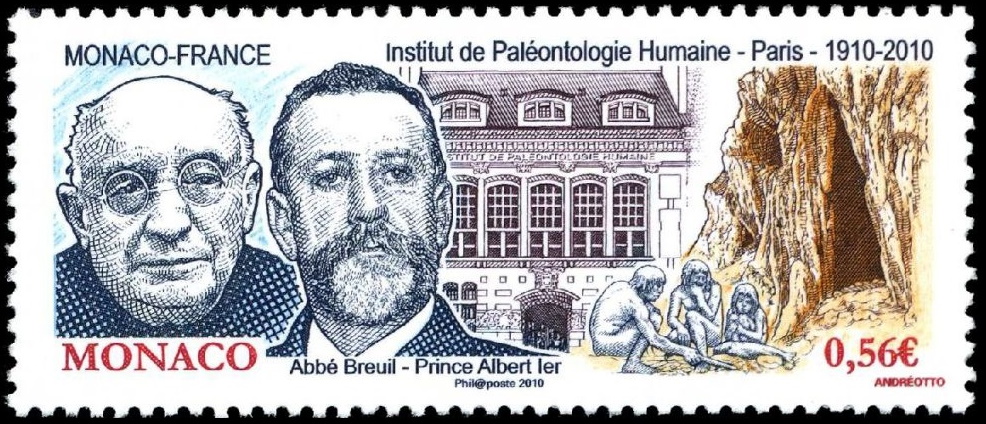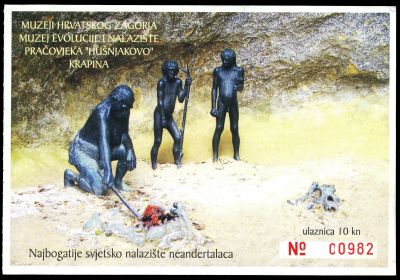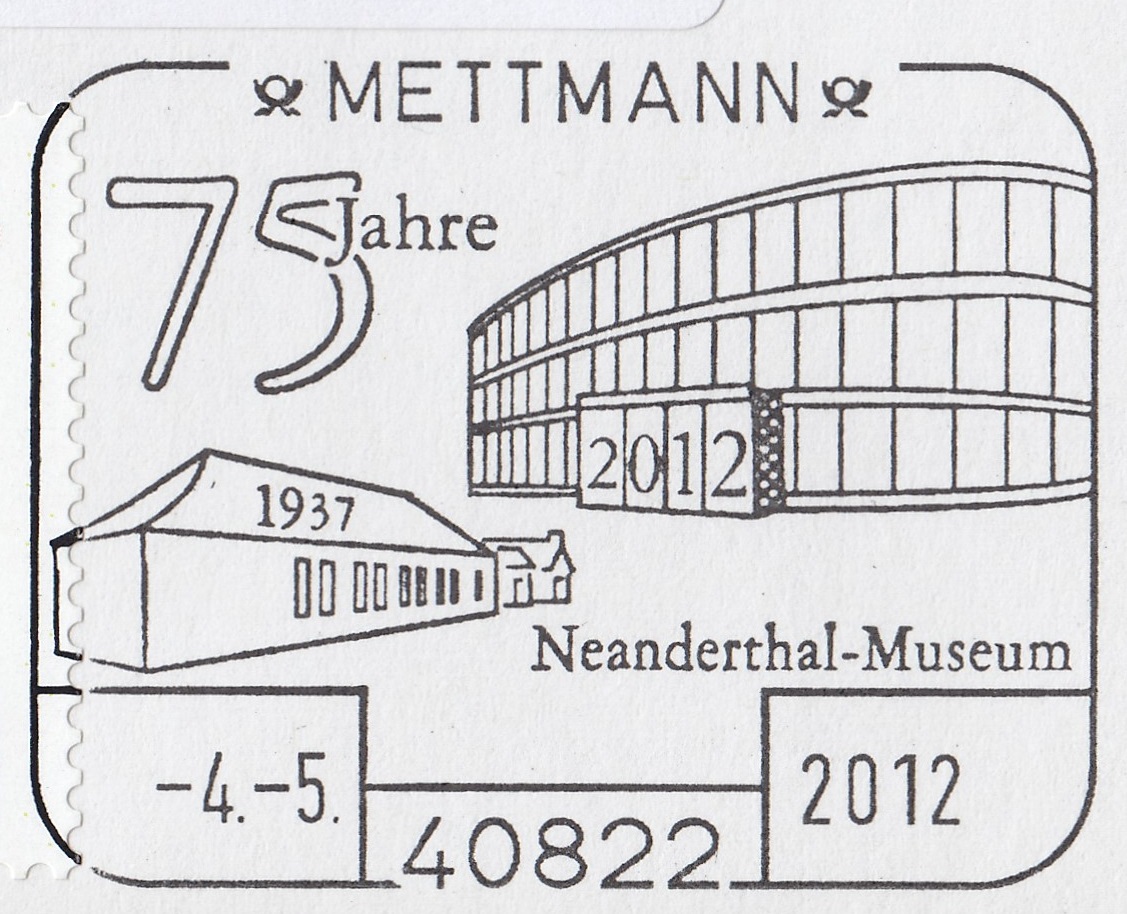the place where Paleontology and Paleoanthropology meets Philately
Paleoanthropological, Research Institutes on stamps and other philatelic items
UNDER CONSTRUCTION
The list Museums and the Research Institutes:
China: The Zhoukoudian Peking Man Site Museum,
 |
| The first building of The Zhoukoudian Peking Man Site Museum and the Peking man head reconstruction on permanent postmark of China 2000. |
The Museum was constructed in 1953 just 500 meters away from the Longgu Hill, where the first complete fossilized Peking Man skullcap was excavated by Chinese paleontologist Pei Wenzhong in 1929.
Big skulpture of the Peking Man's head was installed in the front of the building.
In July 2011 construction of the new musuem building started.
The new museum opened its doors to the public on May 18, 2014.
The museum’s building covers an area of 8,000 square meters and its rough architectural form originates from the important cultural element of Zhoukoudian site - stone tools.
The museum holds a collection of over 7,000 cultural relics, 1000 of which are on permanent display All were collected from excavations at the Zhoukoudian Peking Man Site over the years.
It has temporary exhibitions, basic displays and 4D theatres. It is a natural science museum that integrates the functions of display, collection, scientific research, education, and service. [R1]

The Zhoukoudian Peking Man Site Museum on cachet of a postal stationery of China 2018 and reconstruction of the Peking Man on commemorative postmark of China 2018. |
Known Philatelic items:
- The permanent Chinese postmark of Zhoukoudian site, show the old Museum building and the Peking man head reconstruction statue. This postmark was available from 2000 to 2006, at least (more precise information WANTED).
- Pstal stationery of China 2018 shows the buiding of the new Museum on the cachet and the Peking man head reconstruction statue on the imprinted stamp.
- There are many Chinese postmarks and meter frankings with reconstruction of the Peking man.
The stamp of China from 1991 "13th Conference of International Union for Quaternary Research", MiNr: 2380 A/C, Scott: 2346/2346a and the postal stationery of China from 1989 "60th Anniversary of the Discovery of the first skull of Peking Man" shows some reconstructions of the Peking man.
Croatia: Krapina Neanderthal Museum,
The Krapina Neanderthal was first discovered by Dragutin Gorjanovic-Kramberger,
who excavated the site between 1899 and 1905 and subsequently published two monographs.
Some nine hundred human fossil bones were found in the cave's sandstone deposits, which were 8 meters high.
This is the largest and most abundant collection of Neanderthal people collected at a single locality.
The bones belong to the fossil remains of several dozen individuals, both male and female, from 2 to 40 years of age.
The museum was called the Heritage Museum of Krapina, it showcased the total history of the area, beginning with select prehistoric Neanderthal finds, and up to the Yugoslav Partisans.
By 1966, two more exhibitions were added: the family pictures of dr. Ljudevit and the ethnography exhibition. During this time, there was no museum dedicated specially to the Neanderthals.
The idea of a specialized museum was first brought forward in 1999. As the adaptation and renovation of already existing structures appeared to be more expensive than building a new one, the idea of making a new one from the ground up was accepted. As such, by 2002. work on the new museum began.
The new museum was completed in 2010. It was built into a small hill, with the majority of the building front being made of glass. The entrance to the building opens up into a large oval atrium of grey concrete, the opposite of which is a broad screen which continuously plays documentary films on Krapina Neanderthals. The passage up to the second floor is of a circular shape, with museum pieces being place in the open space, as well as along the painted walls.
The interior of the Museum is made of concrete, and is made to mimic stone, thus reinforcing the effect of a prehistoric habitat, while the visitor, just like the Neanderthal man used to, can observe the surroundings. he rhythm and the density of the exhibits change, as well as the colours of the surrounding space, its sounds, odours and atmosphere. The organic architectural form evokes the womb, the embryo, the snail’s spirals or a replica of the human brain. This actually corresponds to the place and the significance of Neanderthals in the evolution of mankind. [R2]
Known Philatelic items:
- The entrance of Krapina Neanderthal Museum on the cachet of FDC of Croatia 2012.
- The logo of Krapina Neanderthal Museum on stamps and a Min-Sheet corner "Museum Of The Krapina Neanderthal Man " Croatia 2012.
- The logo of Krapina Neanderthal Museum on commemorative postmark "Museum Of The Krapina Neanderthal Man" Croatia 2012.
Czech: The Moravian Museum in Brno
The Moravian Museum was founded in July 1817 by a decree of Emperor Francis II.
 |
| "100th anniversary of the Moravian Museum in Brno" of Czech Republic from 2017. |
The most important exhibit is the Venus of Dolní Věstonice, although only one copy is exhibited in the main building, Palais Dietrichstein, for reasons of conservation.
In addition to the inventory and scientific research work, the museum organizes exhibitions, lectures and excursions and is dedicated to the production of publications and work with children and young people.
The Moravian Museum is subordinate to the Ministry of Culture of the Czech Republic and is a member of the Association of Museums and Galleries of the Czech Republic. [R3]
Known Philatelic items:
- stamp "100th anniversary of the Moravian Museum in Brno" of Czech Republic from 2017, MiNr.: 931, Scott: 3714 (see above).
France: The Institute of Human Paleontology (Institut de Paléontologie Humaine, or IPH)
The Institute of Human Paleontology is a research foundation devoted to the study of human paleontology and prehistory.
 |
| Cover of the Institute of Human Paleontology, Paris, France 1913. |
 |
 |
| "100th anniversary of the Institute of Human Paleontology" joint issue of France and Monaco from 2010. |
The Institute of Human Paleontology (IPH), was recognized as being of public utility by decree of the President of the french Republic of December 15th, 1910.
The IPH is the third oldest scientific foundation in France, after the Pasteur Institute and the Oceanographic Institute of Paris, which were also a foundation of Prince Albert I of Monaco.
The headquarters of the Institute is in Paris in a building built in 1912 by architect Pontremoli and decorated with bas-reliefs by sculptor Constant Roux.L institute's research mission on the ground (archaeological sites) and in laboratories, conservation products of excavation (collections of prehistoric artifacts and bones), dissemination to the greatest number of research results (scientific meetings and publications, exhibitions, public lectures, international exchanges ...) and training of future prehistory.The Institute of Human Paleontology is administratively managed by a Franco-Monegasque board equally consisting of eight members and its action is under the control of a scientific advisory board consisting of nine French and foreign personalities. [R4]
Known Philatelic items:
- stamp "100th anniversary of the Institute of Human Paleontology" of France from 2010, MiNr.: 4870, Scott: 3821 (see above).
- stamp "100th anniversary of the Institute of Human Paleontology" of Monaco from 2010, MiNr.: 3000, Scott: 2597 (see above).
- stamp from a set "100th anniversary of Prince Albert I" of Monaco from 1949, MiNr.: 366, Scott: C22.
France: The Museum of Tautavel European Center of Prehistory
 |
| 450.00 years of Tautavel man on postmark of France 1985. |
 |
| The Museum of Tautavel European Center of Prehistory on postmark of France 1981. |
This museum is dedicated to 450,000 year old Tautavel Man, the oldest human remains ever found in France. In the summer there are many special activities, including occasional tours of the cave. [R5]
Tautavel Man, an early hominid and some of the oldest human remains in Europe.
He is considered to be an ancestor of the Neanderthals.
Its remains were found in Caune de l'Arago, a cave in Tautavel commune in France.
The cave was inhabited from about 600,000 to 400,000 years ago.
Tautavel Man (Homo erectus tautavelensis) is a proposed subspecies of Homo erectus,
the type specimen being 450,000-year-old fossil remains discovered in the Arago Cave at Tautavel, France.
Excavations began in 1964, with the first notable discovery occurring in 1969.
All fossils recovered from Arago were found by Henry and Marie-Antoinette de Lumley and are now located at the
Institute for Human Palaeontology in Paris.
Known Philatelic items:
- postmark of France 1969-2005, see above.
- Fossils and reconstructions of the Tautavel Man appeared on many postmarks France and the stamp of France in 1992.
France: The National Museum of Prehistory in les Eyzies
 |
 |
| Some artifacts from collection of the National Museum of Prehistory in les Eyzies on postmarks of France. |
The museum is located in Les Eyzies, often called the capital of prehistory as is sits at the heart of the prehistoric sites of the Vezere Valley.
The Vezere Valley is so rich in prehistoric caves and shelters that it is a UNESCO World Heritage Site.
The highlights of the museum including the skeleton of a newborn Neanderthal baby from 40000 years ago.
This was found in a shelter at nearby Le-Moustier and is one of the most complete Neanderthal skeletons in Europe.
Another is the skeleton of a young Neanderthal found at the nearby La Madeleine shelter. The skeleton dates back 10000 years and was buried with lots of ornaments.
These ornaments are made of pierced shells and teeth and were probably sewn on to clothing.
The Neanderthals were the first to bury their dead in Europe, an indication of symbolic thinking and social structuring.
Known Philatelic items:
- postmark of France 1969-2005, see above.
- Fossils and reconstructions of the Tautavel Man appeared on many postmarks France and the stamp of France in 1992.
Germany: Neanderthal Museum in Mettmann (near Duesseldorf)
In 1856 remains of the skull and other skeletal parts of a "Urmenschenart" (prehistoric human) were found in the Neander Valley near Duesseldorf.
Prof. Dr. Johann Carl Fuhlrott (1803 –1877) was the one who recognized them as the remains of a previously unknown type of human, which was then named after discovery place Homo neanderthalensis, more commonly known as "Neanderthal" today.
The comparison with other finds of similar fossils showed that the Neanderthals lived from about 130,000 years ago to about 30,000 years ago.
The first Neanderthal Museum was established on 1 May 1937, in small building, once used as pump house.
The modern Neanderthal Museum was established on 10 October 1996 at the site of the first Neanderthal man discovery in the Neandertal.
The exhibition traces humankind's long journey from the savannah to the metropolises of today, with focus placed on the Neanderthals.
The life-sized figures in the museum were created on the basis of fossil finds and scientific reconstruction methods.
The museum also includes an archaeological park on the original discovery site, a Stone Age workshop, as well as an art trail named "human traces".
All signs in the museum as well as the audio guide offered by the museum are available in German and English.
The museum has a unique collection of casts of the original human fossils which represent the evolution of the hominids in general and that of the Neanderthals in particular.
This cast collection, prepared on the basis of finds from various excavated sites in the world.
With around 160,000 visitors per year, the Neanderthal Museum is among the most popular archaeological museums in Germany.
Known Philatelic items:
The building of the Neanderthal Museum
- postmark "150th years of discovery of Neanderthal", Germany 2006
- meter franking "2006 - the year of Neanderthal", Germany 2006
- postmark "75th years of Neanderthal Museum (1937-2012)", Germany 2012
- meter franking "Neanderthal Museum", issued by the Neanderthal Museum in 2012
- commemorative stamp "150th years of discovery of Neanderthal", Germany 2006
- personalized self-adhesive stamp "75th years of Neanderthal Museum (1937-2012)", issued by the Neanderthal Museum, Germany 2012
- postmarks "150th years of discovery of Neanderthal", Germany 2006: [1], [2], [3], [4], [5], [6], [7].
- personalized self-adhesive stamps "160th anniversary of Neandertal discovery (1856-2016)"
References:
- [R1] Zhoukoudian Peking Man Site Museum, China: official website. China Daily, koryogroup.
- [R2] Krapina Neanderthal Museum, Croatia:
official website.´,
ice-age-europe.eu.
Krapina Neanderthal site: - [R3] The Moravian Museum in Brno:
official website,
Wikipedia,
Official stamp release of Czech Post.
Venus of Dolní Věstonice:
Wikipedia - [R4] The Institute of Human Paleontology, France: official website, Wikipedia (in French)´.
- [R5] Museum of Prehistory Tautavel, France: official website, Wikipedia, prehistorictourist, Tautavel Man (Wikipedia).
- [R6] Neanderthal Museum official website, Wikipedia, neanderthal-blog.de (in German), issuu.com (in German),
Acknowledgements:
- Many thanks to fellow collector Peter Brandhuber from Germany (who run Evolution of mankind and Philately group on facebook) for his help to find and identify many postmarks of China related to Paleoanthropology and who also provided me many good scans from his own collection.





